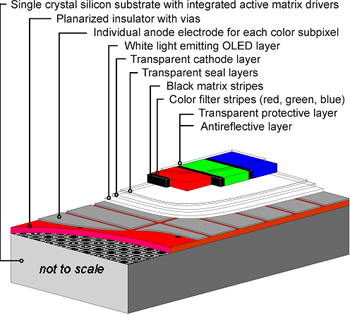OLED stands for Organic Light Emitting Diode. The “organic” in OLED refers to organic material. Carbon is the basis of all organic matter. Examples of carbon-based substances include sugar, wood and the majority of plastics. The “LED” stands for “Light Emitting Diode” and describes the process of converting electric energy into light. There are two types of OLEDs small molecule OLED and polymer OLED.
is a light-emitting diode (LED) whose emissive electroluminescent layer is composed of a film of organic compounds. This layer of organic semiconductor material is formed between two electrodes, where at least one of the electrodes is transparent.
Such devices can be used in television screens, computer monitors, small, portable system screens such as mobile phones and PDAs, watches, advertising, information and indication. OLEDs can also be used in light sources for general space illumination, and large-area light-emitting elements. Due to the younger stage of development, OLEDs typically emit less light per unit area than inorganic solid-state based LEDs which are usually designed for use as point-light sources.
In the context of displays, OLEDs have certain advantages over traditional liquid crystal displays (LCDs). OLED displays do not require a backlight to function. Thus, they can display deep black levels and can be thinner and lighter than LCD panels. OLED displays also naturally achieve higher contrast ratios than either LCD screens using cold cathode fluorescent lamps (CCFLs) or the more recently developed LED backlights in conditions of low ambient light such as dark rooms.
There are at least two types of OLEDs: those that are based on small molecules and those that employ polymers. Adding mobile ions to an OLED creates a Light-emitting Electrochemical Cell or LEC, which operates slightly differently than an OLED.

